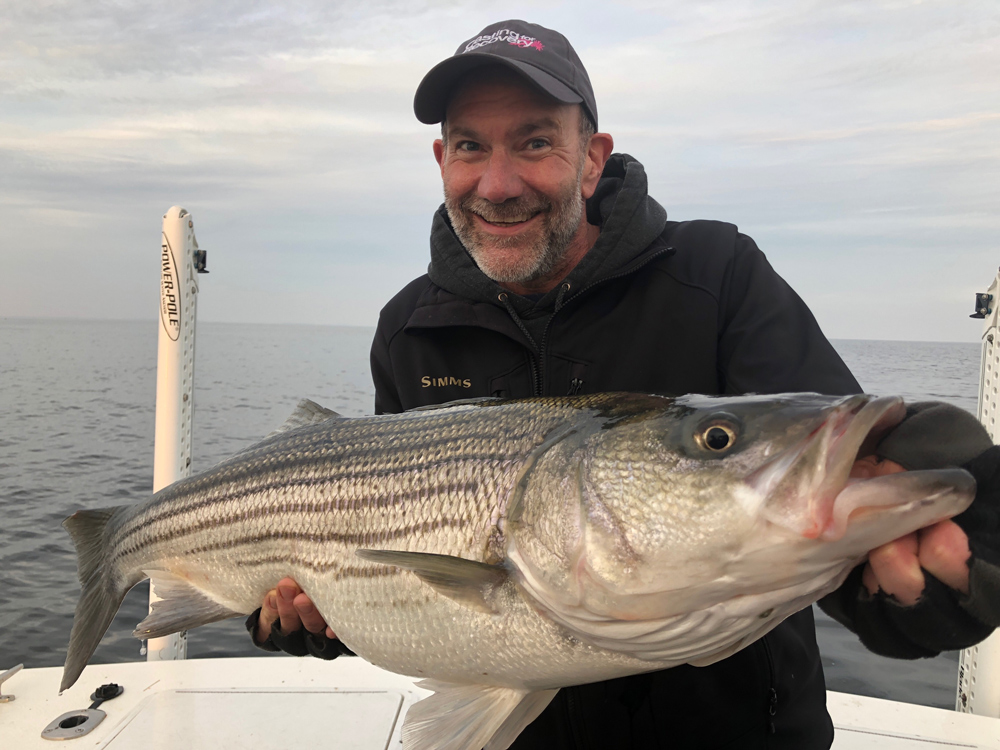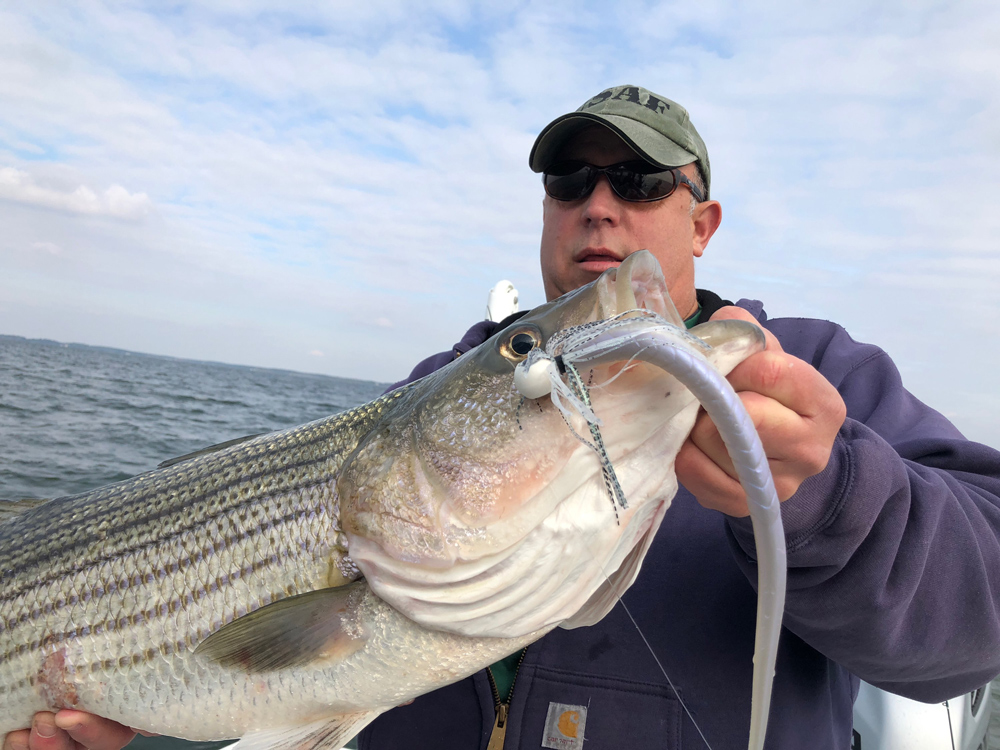Just as many folks are winterizing boats at the end of the fall, the fishing is actually blasting off – the average size striper is typically larger than all other months of the year and the fish have massed up into huge schools. Many can be jigged, surface plugged, and even fly fishing can be spectacular. Although the weather is volatile the fishing is some of the best of the year.

As the water temperature drops below 50 degrees in the shallows around Chesapeake Bay, baitfish migrate out into deeper warmer waters. Following right behind are the stripers. The key to locating last chance stripers is absolutely birds. The incredible northern gannet migrates huge distances to partake in feeding on menhaden in Chesapeake Bay at this time of year, and along with the gannet is every species of sea gull on the Bay.
Smaller gulls eat silver sides (bay anchovies), a small baitfish. Very large brown gulls and other large seabirds, plus those northern gannets, eat the larger menhaden that gather in regions from up the Potomac River to well up Chesapeake Bay north of Solomon’s Island. Small gulls hitting the surface will often be feeding on small bait, and small stripers are underneath, while larger birds often indicates larger bait with larger stripers underneath. The area I fish from late November through the end of the Maryland striped bass season (This year, to December 15) has, for several years running, typically been from Solomons Island down to the Virginia state line out from Smith Point, Virginia.
Baits and Tackle I Use and Love
Being that last chance stripers are typically bigger and the chance exists to catch a true giant, even up into the 50-inch range, I use Back Yard Custom Rods 6’8” medium heavy action spinning rods, paired with Penn Clash 4000 reels loaded with 14- or 20-pound flame green Fireline and a 30-pound fluorocarbon leader for abrasion resistance. The baits I use at this time vary depending on where in the water column the fish are feeding and what are they eating. But nothing I do is complicated, and it’s all dependent on where the fish are in the water column and what they are eating.
Typically, when waters are 50 degrees or cooler on the surface fish will be holding in waters 25 to 90 feet deep. They move around, chasing bait all the time. Usually when the water temperature falls down in the low to mid 40s the fish will be closer to the shipping channel, opting to be in waters 50’ or more deep. Yet at times even when water is 40 to 45 degrees, fish can be found chasing bait on the surface. The key to locating these large stripers in December is, as we said, locating the birds, though occasionally with no birds around you can find them on shipping channel edges where waters go from 45 or 50 down to 90 and beyond, or in water 35 to 45 feet deep in the mouth of the Potomac River near Point Lookout.
Situational Awareness When Striper Fishing
One common scenario to encounter from Buoy 72A down to buoy 66, and across to the mouth of the Potomac River, is to find the fish finder lit up with fish 30 feet thick from 15 down to 45 feet. Since the fish are not on top in this situation (see the fish finder screen shot) we wouldn’t sling a surface plug. What we’d use now is either a heavy metal jig of three or four ounces, like a Specialized Baits Lil’ Bunker Spoon, a Sting Silver, or Hopkins Spoon in silver or chartreuse, or a two-ounce skirted jig head with a six or 10 inch BKD (Bass Kandy Delight). I like to drop the Lil’ Bunker Spoon down and detect bottom, immediately and sharply lift the rod about two to four feet, and then follow the jig back down with the rod tip at the speed it would fall naturally. If there are no hits after four or five jigs, turn the reel a few cranks and work the jig again, now higher in the water column. A hit occurs almost always as the lure is falling, after the twitch up. An extremely important thing to remember is to never let slack in the line when the jig is falling. Slack in the line will make it hard or impossible to feel the hit – always stay in touch with your jig! If you’re fishing on my boat and you allow slack in the line while jigging I’ll hit you with a taser (almost).
When I leave Buzz’s Marina in Ridge, MD in late November and December, I’ll head out about two miles and get the binoculars out to look for bird activity. Every day is different and birds can appear and disappear from an area day to day, so you have to get out there and start running and glassing. About every 1.5 miles I stop and look for birds again.
Suspension Intervention: Suspended Fish Under Birds
My favorite technique when fishing schools of fish suspended under birds is to throw out a 10 inch BKD on a skirted jig head, the head weight dependent upon how deep the fish are and how fast your drift is. The deeper fish are holding and the faster the drift is, the heavier the jig head that’s needed. The heaviest I go in December is generally three ounces and the lightest is one ounce. I like chartreuse and/or white jig heads and I love chartreuse glitter BKD’s in the sun, and purple glitter in overcast or low-light conditions.
The technique with a BKD is pretty easy. Instead of dropping straight down as with the spoon I like to cast out, and cut line out until I think I’m near the bottom. The retrieve I then use is a short six to 12 inch very sharp twitch. During the twitch take in line, to maintain tension. Remember, no slack should be in the line. Stop reeling and follow the rod tip back down 12 inches or so, and if a hit occurs you’ll feel a good THUNK! Making the lure look erratic is important, so it appears to be an injured baitfish. Continue this technique until your jig is back at the boat or you’ve hooked a fish.
When birds are going crazy on the top and you can see the fish blasting, surface plugs are a great choice. I like a large Stillwater Smack-It, worked aggressively. Surface feeding stripers just can’t say no to this bait. Also in this situation, a favorite is loading up a one ounce jig head with a 10 inch BKD. Cast it out over the active fish and work it aggressively at the top – again, big stripers can’t say no to this bait. Just make your offerings look like a feverishly retreating baitfish swimming for its life, and you can get in on some last chance stripers before hanging up your rods for the season.

Maryland and Virginia Launch Points
To fish the region from Buoy 72A down to the buoy 66 region, launching from Buzz’s Marina in Ridge, MD, is perfect. Plus it’s a great little marina with the best folks ever! To launch directly into the Potomac River from Maryland very close to productive December water, Point Lookout State Park is right there. If you’re on the Eastern Shore a good launch is the boat ramp on Hooper Island in Hoopersville. Running out through Hooper Straights to buoy 72A and south is a good route to run looking for last chance stripers. The public ramp at Deale Island is a pretty long run, but also within reach. (Note: the public ramp at Solomon’s Island remains closed until sometime in 2019).
Virginia anglers (who can fish through the end of December) have a range of options on the Western Shore and can launch at areas like Smith Point Marina, which gives you access to the main-stem Bay. Bonum Creek Landing, off Bonum Creek, provides access near the mouth of the Potomac. A bit farther south Cockrell Creek landing puts you out in the Great Wicomico.
Winter Fishing Safety Check
When venturing out on Chesapeake in late November and December great care has to be taken to be safe. Having a working cell phone, VHF marine radio, and backup handheld marine radio is a good idea. Take your time in evaluating the wind forecast. If the wind is going to be sustained at 20 knots or more it will be brutal unless you’re on a cruise ship. Always dress in layers, and thin gloves can be good. All life jackets should have a water-activated strobe light affixed. Always leave your float plan with your spouse or someone reliable. Having a dry-bag with a fresh change of clothes will be great if you get wet. The mouth of the Potomac River and the entire region can have a surprising amount of boat traffic at times even in December, so be very careful and always be on the lookout for boats running hard your way and where you are headed.
-By Capt. Pete Dahlberg, Four Seasons Guide Service